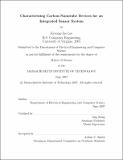Characterizing carbon-nanotube devices for an integrated sensor system
Author(s)
Lee, Kyeong-Jae
DownloadFull printable version (1.151Mb)
Alternative title
Characterizing CNT devices for an integrated sensor system
Other Contributors
Massachusetts Institute of Technology. Dept. of Electrical Engineering and Computer Science.
Advisor
Jing Kong.
Terms of use
Metadata
Show full item recordAbstract
While carbon nanotubes (CNT) offer promise for future nano-electronic applications, reliably controlling CNT growth has been a big challenge. As-grown devices can have a number of different nanotubes, which can be either metallic or semiconducting and also vary in diameter. These factors affect the electrical properties, which are important in particular for chemical sensing applications. In this thesis, arrays of CNT field-effect transistors (FET) are fabricated and the resistance variation of as-grown devices is characterized. Each CNT array is exposed under varying concentrations of NO2 as the conductance is monitored. The effects of gas adsorption on the metal contact and the CNT channel are treated separately in this work. A charge transfer and site-binding model is applied to understand the CNT-NO2 interaction, and a Schottky-barrier modulation effect is used to describe the metal-NO2 interaction. This model is applied to both the transient and steady-state response of the normalized conductance change for various devices. Devices of a different design are also fabricated, either by selectively exposing certain regions of a device to NO2 or using a different metal contact. The response of such devices show the importance of gas molecules interacting with both the metal and CNT. Finally, a prototype CMOS-CNT sensor system is demonstrated. This hybrid system demonstrates the need for variation-toleration circuit interfaces and highlights some outstanding issues regarding integration for full scale CNT circuit applications.
Description
Thesis (S.M.)--Massachusetts Institute of Technology, Dept. of Electrical Engineering and Computer Science, 2007. This electronic version was submitted by the student author. The certified thesis is available in the Institute Archives and Special Collections. Includes bibliographical references (p. 51-56).
Date issued
2007Department
Massachusetts Institute of Technology. Department of Electrical Engineering and Computer SciencePublisher
Massachusetts Institute of Technology
Keywords
Electrical Engineering and Computer Science.